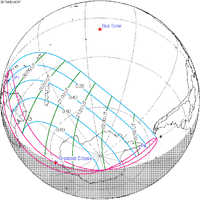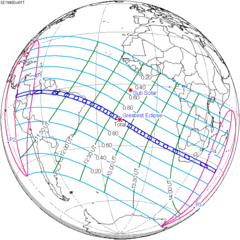| Total eclipse | |||||||||||||||||
 The Moon's hourly motion shown right to left The Moon's hourly motion shown right to left | |||||||||||||||||
| Date | October 7, 1949 | ||||||||||||||||
|---|---|---|---|---|---|---|---|---|---|---|---|---|---|---|---|---|---|
| Gamma | −0.3219 | ||||||||||||||||
| Magnitude | 1.2236 | ||||||||||||||||
| Saros cycle | 126 (42 of 72) | ||||||||||||||||
| Totality | 72 minutes, 50 seconds | ||||||||||||||||
| Partiality | 222 minutes, 53 seconds | ||||||||||||||||
| Penumbral | 369 minutes, 11 seconds | ||||||||||||||||
| |||||||||||||||||
| ← April 1949April 1950 → | |||||||||||||||||
A total lunar eclipse occurred at the Moon’s ascending node of orbit on Friday, October 7, 1949, with an umbral magnitude of 1.2236. A lunar eclipse occurs when the Moon moves into the Earth's shadow, causing the Moon to be darkened. A total lunar eclipse occurs when the Moon's near side entirely passes into the Earth's umbral shadow. Unlike a solar eclipse, which can only be viewed from a relatively small area of the world, a lunar eclipse may be viewed from anywhere on the night side of Earth. A total lunar eclipse can last up to nearly two hours, while a total solar eclipse lasts only a few minutes at any given place, because the Moon's shadow is smaller. Occurring only about 15 hours before apogee (on October 7, 1949, at 18:10 UTC), the Moon's apparent diameter was smaller.
This lunar eclipse was the second of a tetrad, with four total lunar eclipses in series, the others being on April 13, 1949; April 2, 1950; and September 26, 1950.
Visibility
The eclipse was completely visible over eastern North America, South America, and west Africa, and western Europe, seen rising over western North America and the eastern Pacific Ocean and setting over much of Africa, Europe, and west, central, and south Asia.
 
|
Eclipse details
Shown below is a table displaying details about this particular solar eclipse. It describes various parameters pertaining to this eclipse.
| Parameter | Value |
|---|---|
| Penumbral Magnitude | 2.31179 |
| Umbral Magnitude | 1.22363 |
| Gamma | −0.32191 |
| Sun Right Ascension | 12h49m43.2s |
| Sun Declination | -05°20'02.0" |
| Sun Semi-Diameter | 16'00.3" |
| Sun Equatorial Horizontal Parallax | 08.8" |
| Moon Right Ascension | 00h50m16.7s |
| Moon Declination | +05°04'46.9" |
| Moon Semi-Diameter | 14'42.5" |
| Moon Equatorial Horizontal Parallax | 0°53'58.9" |
| ΔT | 29.0 s |
Eclipse season
See also: Eclipse cycleThis eclipse is part of an eclipse season, a period, roughly every six months, when eclipses occur. Only two (or occasionally three) eclipse seasons occur each year, and each season lasts about 35 days and repeats just short of six months (173 days) later; thus two full eclipse seasons always occur each year. Either two or three eclipses happen each eclipse season. In the sequence below, each eclipse is separated by a fortnight.
| October 7 Ascending node (full moon) |
October 21 Descending node (new moon) |
|---|---|
 |

|
| Total lunar eclipse Lunar Saros 126 |
Partial solar eclipse Solar Saros 152 |
Related eclipses
Eclipses in 1949
- A total lunar eclipse on April 13.
- A partial solar eclipse on April 28.
- A total lunar eclipse on October 7.
- A partial solar eclipse on October 21.
Metonic
- Preceded by: Lunar eclipse of December 19, 1945
- Followed by: Lunar eclipse of July 26, 1953
Tzolkinex
- Preceded by: Lunar eclipse of August 26, 1942
- Followed by: Lunar eclipse of November 18, 1956
Half-Saros
- Preceded by: Solar eclipse of October 1, 1940
- Followed by: Solar eclipse of October 12, 1958
Tritos
- Preceded by: Lunar eclipse of November 7, 1938
- Followed by: Lunar eclipse of September 5, 1960
Lunar Saros 126
- Preceded by: Lunar eclipse of September 26, 1931
- Followed by: Lunar eclipse of October 18, 1967
Inex
- Preceded by: Lunar eclipse of October 27, 1920
- Followed by: Lunar eclipse of September 16, 1978
Triad
- Preceded by: Lunar eclipse of December 6, 1862
- Followed by: Lunar eclipse of August 7, 2036
Lunar eclipses of 1948–1951
| Descending node | Ascending node | |||||
|---|---|---|---|---|---|---|
| Saros | Date viewing |
Type chart |
Saros | Date viewing |
Type chart | |
| 111 | 1948 Apr 23
|
Partial
|
116 | 1948 Oct 18
|
Penumbral
| |
| 121 | 1949 Apr 13
|
Total
|
126 | 1949 Oct 07
|
Total
| |
| 131 | 1950 Apr 02
|
Total
|
136 | 1950 Sep 26
|
Total
| |
| 141 | 1951 Mar 23
|
Penumbral
|
146 | 1951 Sep 15
|
Penumbral
| |
Saros 126
It is part of saros series 126.
Lunar saros series 126, repeating every 18 years and 11 days, has a total of 70 lunar eclipse events including 14 total lunar eclipses. Solar Saros 133 interleaves with this lunar saros with an event occurring every 9 years 5 days alternating between each saros series.
First penumbral lunar eclipse: 18 July 1228
First partial lunar eclipse: 24 March 1625
First total lunar eclipse: 19 June 1769
First central lunar eclipse: 11 July 1805
Greatest eclipse of the lunar saros 126: 13 August 1859, lasting 106 minutes.
Last central lunar eclipse: 26 September 1931
Last total lunar eclipse: 9 November 2003
Last partial lunar eclipse: 5 June 2346
Last penumbral lunar eclipse: 19 August 2472
1901-2100
Half-Saros cycle
A lunar eclipse will be preceded and followed by solar eclipses by 9 years and 5.5 days (a half saros). This lunar eclipse is related to two total solar eclipses of Solar Saros 133.
| October 1, 1940 | October 12, 1958 |
|---|---|

|

|
See also
Notes
- "October 6–7, 1949 Total Lunar Eclipse (Blood Moon)". timeanddate. Retrieved 21 December 2024.
- "Moon Distances for London, United Kingdom, England". timeanddate. Retrieved 21 December 2024.
- "Total Lunar Eclipse of 1949 Oct 07" (PDF). NASA. Retrieved 21 December 2024.
- "Total Lunar Eclipse of 1949 Oct 07". EclipseWise.com. Retrieved 21 December 2024.
- Mathematical Astronomy Morsels, Jean Meeus, p.110, Chapter 18, The half-saros
External links
- 1949 Oct 07 chart Eclipse Predictions by Fred Espenak, NASA/GSFC
This lunar eclipse-related article is a stub. You can help Misplaced Pages by expanding it. |


